In the world of starry sky photography, wide-angle lenses are typically favored for capturing expansive views of the night. However, this time we explored a different approach—astrophotography with a macro lens using the Tamron 90mm F/2.8 Di III VXD Macro (Model F072).
This lens doesn’t just frame the vastness of the cosmos—it reveals the intricate beauty within it. Light points that once seemed like distant specks now appear as clearly defined, delicate miracles. From the textured glow of nebulae to the fine structure of celestial orbits, every detail comes to life with stunning depth and charm.
What You Will Learn In This Article:
- How to use a macro lens—specifically the Tamron 90mm F/2.8—for capturing fine detail in starry sky compositions.
- Tips on exposure settings and stacking techniques to enhance astrophotography results with a non-traditional lens.
- Insights into photographing celestial features like nebulae, Orion, and the Milky Way from high-altitude dark sky locations.
Images by Sanzhe
Star Trails and Glacier Reflections at Sister Lake
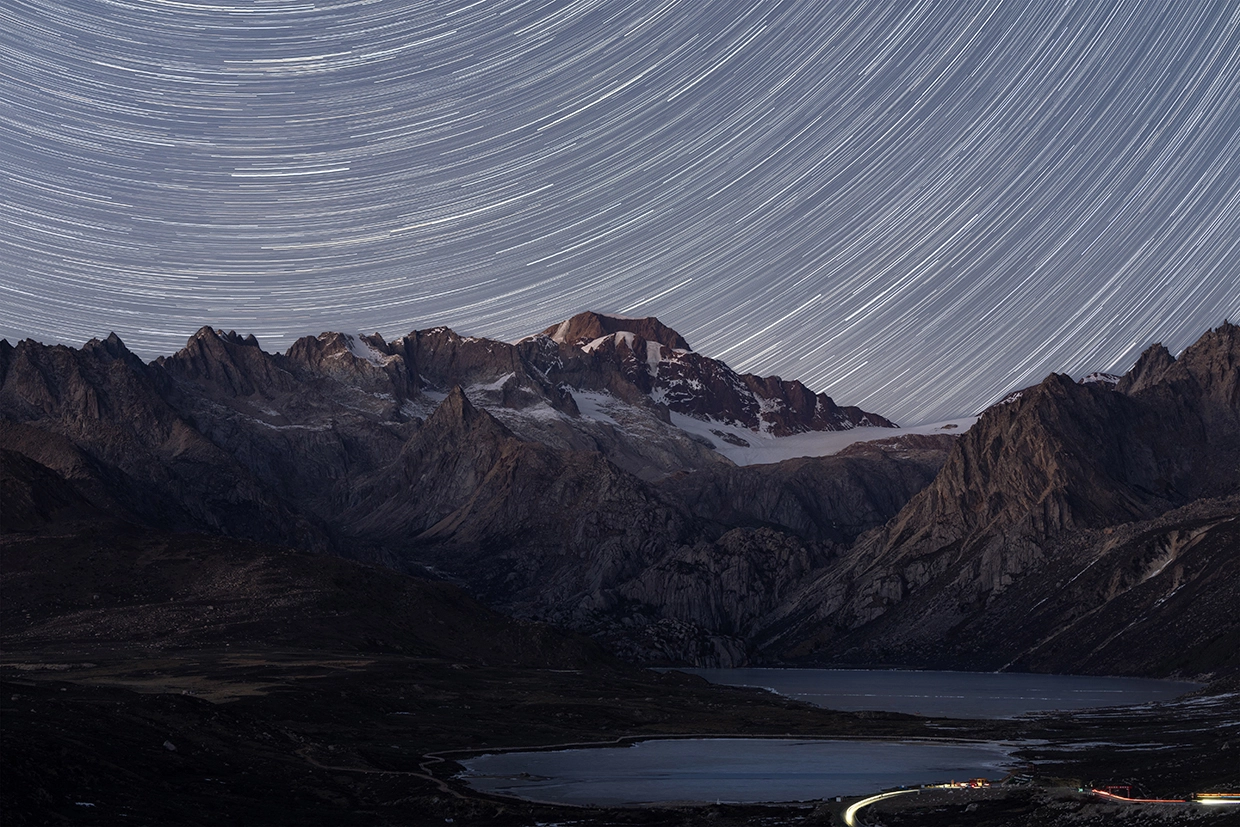
Exposure for landscape section: Focal Length: 90mm | Exposure: F2.8, 120s, ISO800 single shot
The star trails above Sister Lake stretch across the night sky, captured in detail through astrophotography with a macro lens. This location sits beside National Highway 318 and is a popular stop for travelers. The two lakes, part of the Haizishan Nature Reserve, are remnants of ancient glaciers and still hold their deep blue color. After dark, the landscape takes on a cool blue tone while traffic continues along the highway. A crescent moon casts a soft light over the scene, reflecting off Xiasai Snow Mountain, which rises to 5,833 meters. Glacial formations shaped over millions of years provide a striking foreground to this nighttime image.
Tips for Stacking Star Trail Images with a Macro Lens
To achieve the smooth, flowing star trails like those seen over Sister Lake, stacking is a key technique—especially when shooting at a 90mm focal length where motion is more pronounced. Here are a few tips to get you started:
Use an Intervalometer or Time-Lapse Mode
Set your camera to take continuous exposures (e.g., 30s each) with no gap in between. This ensures consistent trails and minimizes gaps in the final composite.
Maintain Consistent Settings
Keep your aperture, ISO, and white balance fixed throughout the sequence. For a macro lens like the Tamron 90mm F/2.8, shooting wide open helps maximize light capture.
Shoot RAW for Flexibility
RAW files retain more detail and dynamic range, giving you better control during post-processing and alignment.
Use Stacking Software
Combine your image sequence using tools like StarStaX, Sequator, or DeepSkyStacker. These programs align and blend multiple frames to form smooth trails while reducing noise.
Include Foreground Separately if Needed
If your landscape is underexposed due to star-friendly settings, consider taking a separate exposure for the foreground and blending it later.
Keep Your Lens Clean and Dew-Free
Long exposures in cold environments can lead to condensation. Use a lens heater or dew shield to avoid image-softening fog on your glass.
By stacking multiple short exposures, you reduce noise, preserve detail, and create the elegant sweeping star trails that make your astrophotography with a macro lens both precise and visually impactful.
Orion and the Barnard Loop: A Perfect Match for 90mm Framing
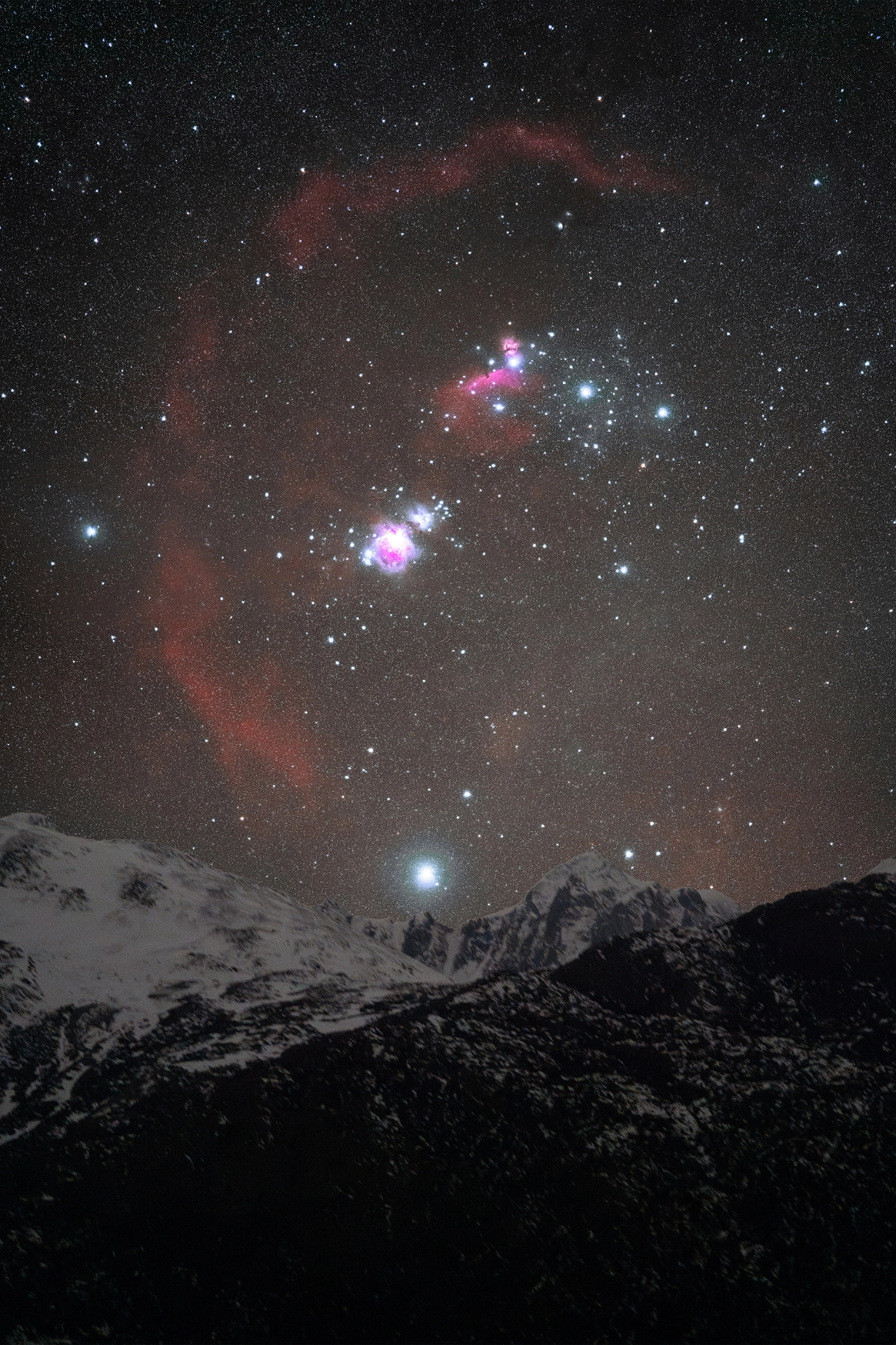
Orion rises above the snow-covered mountains, a highlight of winter night skies for astrophotography enthusiasts. For those drawn to deep-sky objects, Orion is a classic winter target—and with astrophotography using a macro lens, the results are surprisingly detailed. The 90mm focal length proves ideal for framing this region. In this view, the large arc of the Barnard Loop encircles the Orion Belt, glowing red from hydrogen gas energized by ultraviolet light. Within the frame, the Horsehead Nebula, Orion Nebula, and Flame Nebula appear clearly—each one standing out like a distinct bloom in the sky.
Pleiades and California Nebula: Macro for Wide Field Wonders
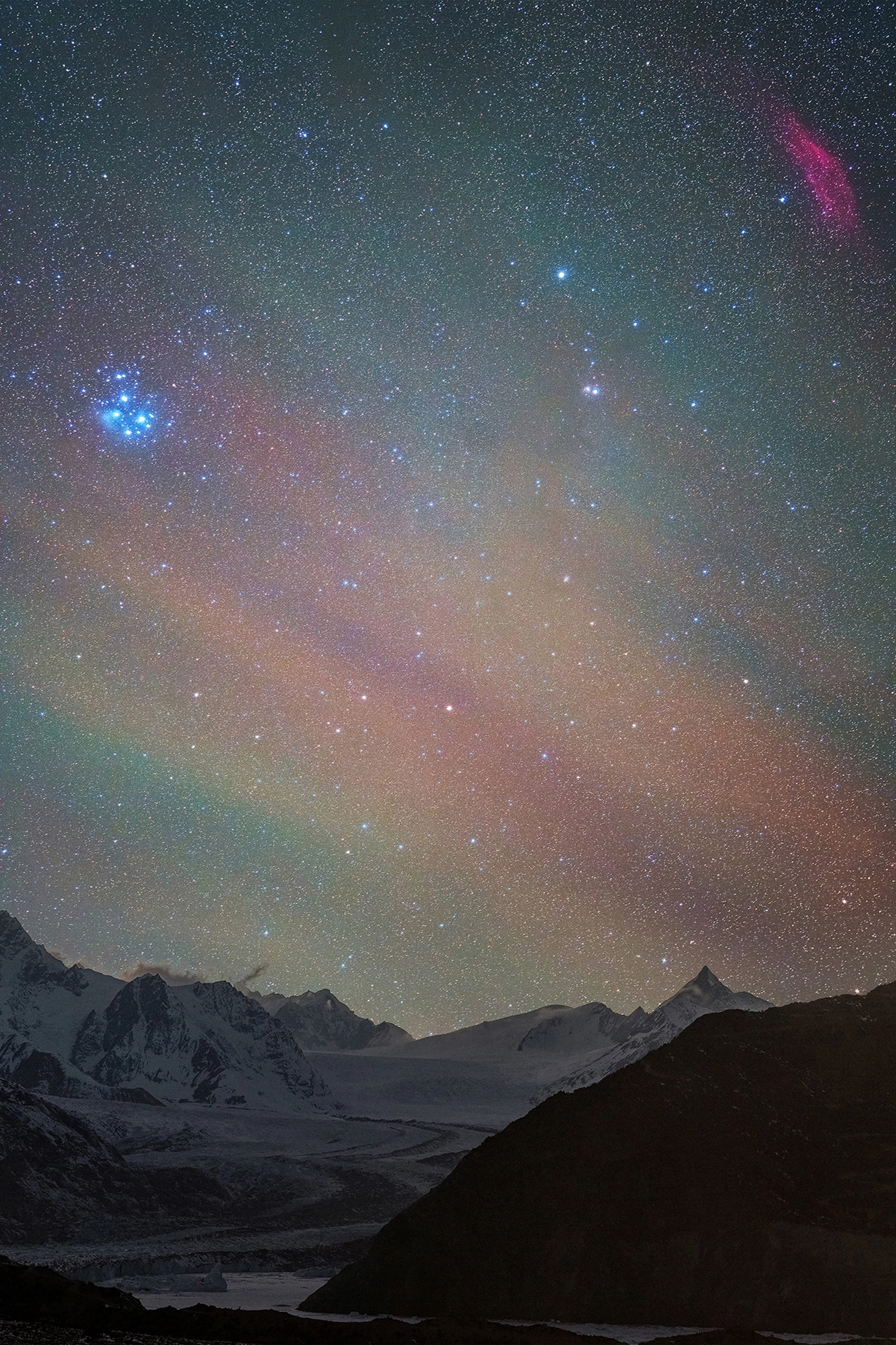
Exposure for landscape section: Focal Length: 90mm Exposure: F2.8, 120s, ISO 3200
The Pleiades and California Nebula appear side by side in the night sky, their colors vivid and striking—captured through astrophotography with a macro lens. This image was taken during a New Year stay at a homestay near Laigu Glacier, a location known for its Level 1 Dark Sky Index. Despite the freezing temperatures, the area draws dedicated stargazers who set up their gear late into the night, facing the Laigulong Glacier. In this exceptionally dark environment, a rare color airglow—produced by the Earth’s upper atmosphere absorbing solar radiation—was visible and recorded. My post-processing brought out even more detail, resulting in a uniquely atmospheric and richly textured image.
February’s Milky Way: A Brief Window to the Galactic Core
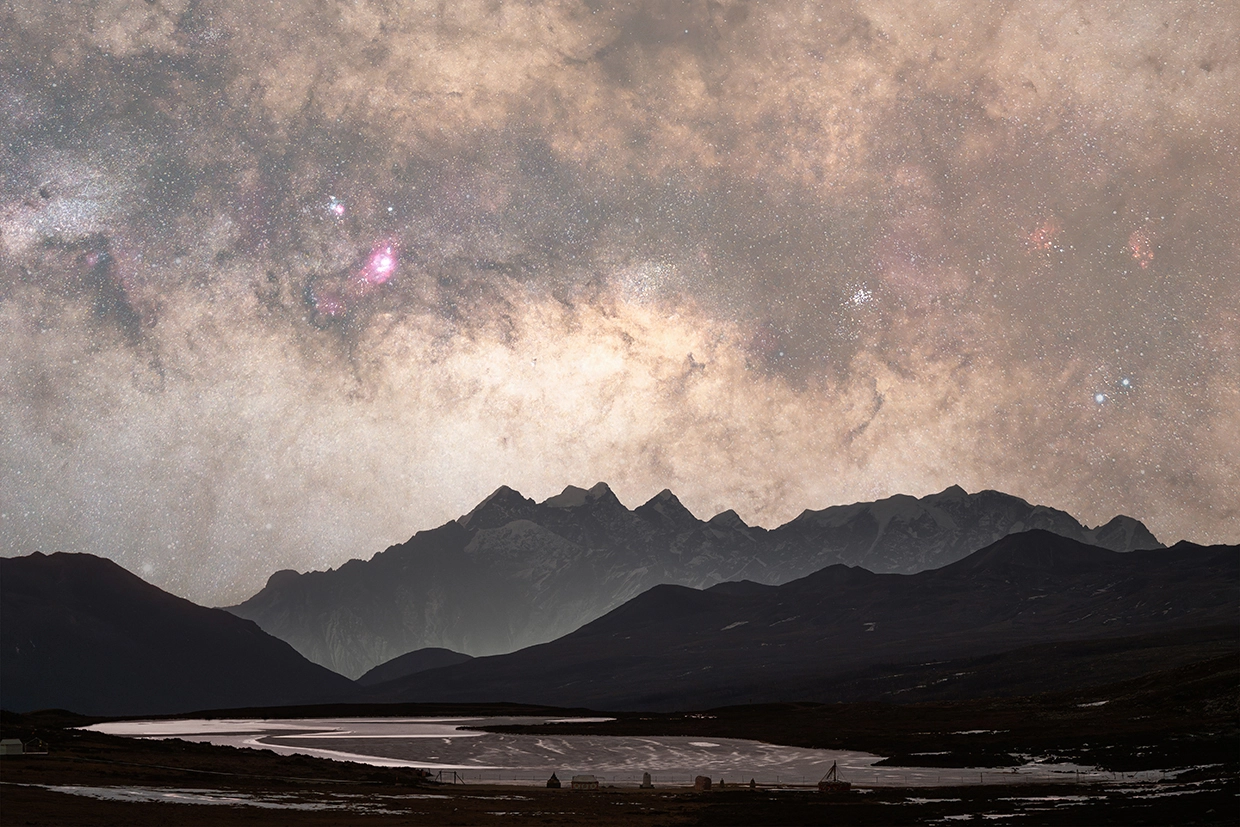
Exposure for landscape section: Focal Length: 90mm Exposure: F2.8, 120s, ISO 800 single shot
The Milky Way in February often catches observers by surprise, as its bright core—sometimes called the silver heart—rises slowly over snow-capped mountains. In astrophotography, we often distinguish between the summer Milky Way (which includes the galactic center) and the winter Milky Way (dominated by the galactic tail). The galactic center, more prominent in summer, appears brighter due to a higher concentration of stars. However, even in February, which is still winter, it’s possible to photograph the galactic core about an hour before dawn. Although the time window is short, astrophotography with a macro lens like the 90mm still captures impressive detail and texture in the Milky Way’s structure.
Nebula Hunting in Cygnus: Macro Detail from the Summer Triangle
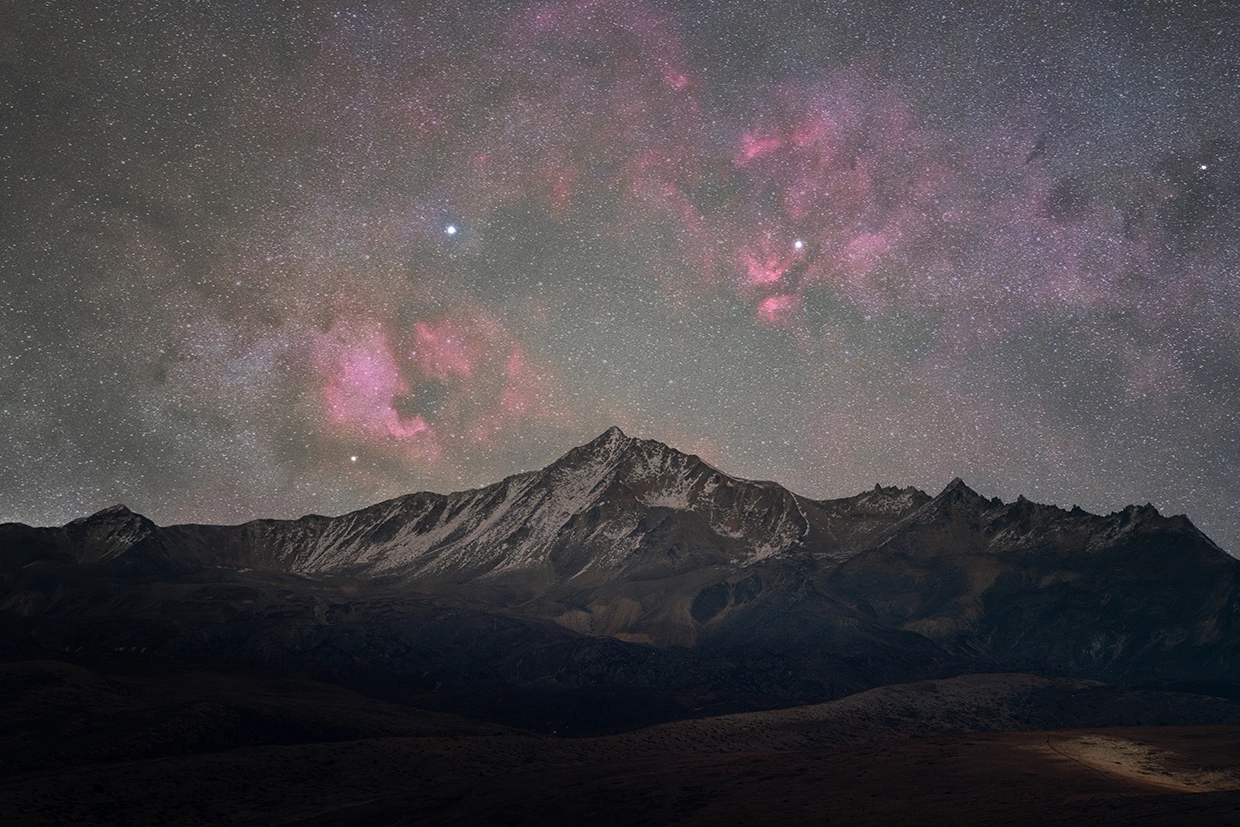
Exposure for landscape section: Focal Length: 90mm Exposure: F2.8, 120s, ISO 800
The Cygnus region of the Milky Way is rich with nebulae and becomes visible shortly after it rises above the northeastern horizon. The constellation’s brightest star, Tianjin Four (also known as Deneb), holds significance in ancient Chinese astronomy and forms part of the well-known Summer Triangle. By locating this star and using long-exposure photography, it’s possible to reveal the intricate structures of nearby nebulae—especially with astrophotography using a macro lens or an astronomical camera. Among the highlights are the North America Nebula (NGC 7000), named for its continental shape; the Pelican Nebula (IC 5070), which resembles an animal; and the diffuse IC 1318, which envelops Tianjin Four in a soft, glowing haze.
Rethinking the Stars: The Macro Lens as an Astrophotography Tool
Astrophotography with a macro lens may seem unconventional, but it opens a fascinating new dimension in capturing the night sky. The Tamron 90mm F/2.8 Di III VXD Macro proves that sharpness, detail, and creativity aren’t limited to traditional wide-angle glass. From glowing nebulae to moonlit glaciers, this lens offers astrophotographers a fresh way to frame the cosmos—one that celebrates both the grandeur and the intricate beauty of our universe.
Learn about the Tamron 90mm Macro lens for astrophotography at your local authorized Tamron dealer or visit the TAMRON Store today.
